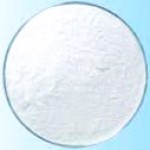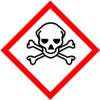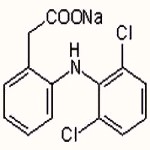CAS Number 15307-79-6, Diclofenac Sodium USP EP IP BP Ph Eur JP Grade Manufacturers Exporters







CAS Number 15307-79-6, Diclofenac Sodium USP EP IP BP Ph Eur JP Manufacturer Exporter
For Properties Specifications of Diclofenac Sodium Click Properties, Specifications of Diclofenac Sodium Manufacturer.
For Uses of Diclofenac Sodium Click Uses of Diclofenac Sodium Manufacturer.
For For SDS MSDS Sheet of Diclofenac Sodium Click SDS Safety Data Sheet MSDS Sheet of Diclofenac Sodium Manufacturer.
The Properties and Specifications of Diclofenac Sodium:
Diclofenac Sodium USP Grade Specifications:
C14H10Cl2NNaO2 --- 318.13
Benzeneacetic acid, 2-[(2,6-dichlorophenyl)amino]-, monosodium salt;
Sodium [o-(2,6-dichloroanilino)phenyl]acetate CAS 15307-79-6
UNII: QTG126297Q
UNII: 144O8QL0L1
DEFINITION
Diclofenac Sodium contains NLT 99.0% and NMT 101.0% of diclofenac sodium (C14H10Cl2NNaO2), calculated on the dried basis.
IDENTIFICATION
A. Infrared Absorption.
B. The retention time of the diclofenac peak of the Sample solution corresponds to that of the System suitability solution, as obtained in the test for Organic Impurities.
C. The residue obtained by igniting it imparts an intense yellow color to a nonluminous flame.
Organic Impurities: To pass the test by chromatography.
Color of Solution: A solution (1 of 20) of Diclofenac Sodium in methanol is colorless to faintly yellow, and the absorbance of the solution, determined in a 1-cm cell at 440 nm, is NMT 0.050, methanol being used as the blank.
Clarity of Solution: The solution prepared as directed under Color of Solution is not significantly less clear than an equal volume of methanol contained in a similar vessel and examined similarly.
pH: A solution (1 of 100) has pH 7.0–8.5
Loss on Drying: Dry at 105C - 110C for 3 h. NMT 0.5%
Diclofenac Sodium BP Ph Eur Grade Specifications:
C14H10Cl2NNaO2 --- 318.1 CAS 15307-79-6
Action and use: Cyclo-oxygenase inhibitor; analgesic; anti-inflammatory.
DEFINITION
Sodium [2-[(2,6-dichlorophenyl)amino]phenyl]acetate.
Content: 99.0 per cent to 101.0 per cent (dried substance).
CHARACTERS
Appearance: White or slightly yellowish, slightly hygroscopic, crystalline powder.
Solubility: Sparingly soluble in water, freely soluble in methanol, soluble in ethanol (96 per cent), slightly soluble in acetone.
Melting Point: About 280C, with decomposition.
IDENTIFICATION
First identification: A, D.
Second identification: B, C, D
A. Infrared absorption spectrophotometry.
B. Thin-layer chromatography.
C. Dissolve about 10 mg in 10 mL of ethanol (96 per cent). To 1 mL of this solution add 0.2 mL of a mixture, prepared immediately before use, of equal volumes of a 6 g/L solution of potassium ferricyanide and a 9 g/L solution of ferric chloride. Allow to stand protected from light for 5 min. Add 3 mL of a 10 g/L solution of hydrochloric acid. Allow it to stand, protected from light, for 15 min. A blue colour develops and a precipitate is formed.
D. Dissolve 60 mg in 0.5 mL of methanol and add 0.5 mL of water. The solution gives reaction of sodium.
TESTS
Appearance of solution: The solution is clear and its absorbance at 440 nm is not greater than 0.05.
Dissolve 1.25 g in methanol and dilute to 25.0 mL with the same solvent.
Related substances: To pass the test by liquid chromatography.
Storage: In an airtight container, protected from light.
We also manufacture Diclofenac Sodium EP IP JP Grade.
The Uses of Diclofenac Sodium:
Diclofenac Sodium is used to reduce pain, swelling, inflammation and joint stiffness from arthritis.
The MSDS-SDS Hazard Statement of Diclofenac Sodium:
Diclofenac Sodium SDS, Safety Data Sheet
MSDS Sheet, Material Safety Data Sheet 08-Nov-24
1. Product Identification
Product Name & Other Names: Diclofenac Sodium.
CAS No.: 15307-79-6
EINECS EC Number: 239-346-4
Relevant uses and uses advised against (if any): Industrial use.
Suppliers: As per letterhead.
2. Hazards Identification
GHS, Globally Harmonized System Classification in accordance with 29 CFR 1910
Classification according to Regulation (EC) No 1272/2008
Acute toxicity, Oral: Category 3, H301
Reproductive toxicity (Category 2), H361
Specific target organ toxicity - repeated exposure, Oral (Category 1), Peripheral nervous system, H372
Labeling according to Regulation (EC) No 1272/2008
GHS Label Elements  Toxic IF SWOLLOWED |
GHS Label Elements |
Signal Words: Danger
Hazard Statements:
H301: Toxic if swallowed.
H361: Suspected of damaging unborn child.
H372: Causes damage to organs through prolonged or repeated exposure.
Precautionary Statements:
P201: Obtain special instructions before use.
P301+P310: IF SWALLOWED: Immediately call a POSION CENTER or doctor/physician.
P260: Do not breathe dust/fume/gas/mist/vapors/spray.
P262: Do not get in eyes, on skin, or on clothing.
P270: Do not eat, drink or smoke when using this product.
P271: Use only outdoors or in a well-ventilated area.
P280: Wear protective gloves/protective clothing/eye protection/face protection.
P314: Get medical advice/attention if you feel unwell.
P302+352: IF ON SKIN: Wash with plenty of soap and water.
P305+351+338: IF IN EYES: Rinse cautiously with water for several minutes.
P337+P313: If eye irritation persists get medical advice/attention.
3. Composition/Information on Ingredients
Product Name & Other Names: Diclofenac Sodium.
CAS No.: 15307-79-6
EINECS EC Number: 239-346-4
4. First Aid Measures
Always seek medical attention after first aid measures are provided.
Inhalation: Remove to fresh air. If not breathing, give artificial respiration. If breathing is difficult, give oxygen. Get medical attention.
Ingestion: Induce vomiting immediately as directed by medical personnel. Never give anything by mouth to an unconscious person. Get medical attention.
Skin Contact: Immediately flush skin with plenty of water for at least 15 minutes. Remove contaminated clothing and shoes. Get medical attention.
Eye Contact: Check for and remove any contact lenses. Immediately flush your eyes with running water for at least 15 minutes, keeping eyelids open. Cold water may be used. Do not use eye ointment. Seek medical attention.
5. Fire Fighting Measures
Fire: Not expected to be a fire hazard. However, it may burn at high temperature.
Fire Extinguishing Media: Water spray, dry chemical, alcohol foam, or carbon dioxide.
Special hazards arising from the substance or mixture: Carbon oxides Nitrogen oxides (NOx), Chlorine compounds and Fumes. Avoid solid water jets as they can scatter the fire.
Special Information: In the event of a fire, wear full protective clothing and NIOSH-approved self-contained breathing apparatus with full face piece operated in the pressure demand or other positive pressure mode.
6. Accidental Release Measures
Personal precautions, protective equipment, and emergency procedures: Avoid breathing dust/fumes/gas/mist/vapors/spray. Use individual protective equipment (waterproof boots, suitable protective clothing, safety glasses, etc.).
Environmental precautions: Do not let the product enter drains, soil, or water sources.
Methods and materials used for containment cleanup procedures and Storage:
Small Spill:Use appropriate tools to put the spilled solid in a convenient waste disposal container.
Large Spill: Do not inhale dust, vapors, mist, or gas. Avoid dust formation. Contain spilled material. Cover with an inert, non-combustible absorbent material, (e.g., sand, earth, diatomaceous earth, vermiculite). Use a shovel to put the material into a convenient waste disposal container.
7. Handling and Storage
Precautions for safe handling: Apply according to good manufacturing and industrial hygiene practices. Ensure proper ventilation. In case of insufficient ventilation, wear suitable respiratory equipment. Do not drink, eat, or smoke while handling. Avoid contact with skin, eyes, and clothing. Minimize dust generation. Avoid breathing dust/fumes/gas/mist/vapors/spray. Keep container tightly closed. Avoid ingestion and inhalation. Use individual protective equipment (waterproof boots, suitable protective clothing, safety glasses, etc.).
Conditions for safe storage, including any incompatibilities: Store in cool, dry, and ventilated area away from heat sources and protected from sunlight in tightly closed original container. Keep air contact to a minimum. Store protected from heat, sparks and ignition sources and incompatible materials. Avoid inhalation of dust/mist/vapor. Do not store with incompatible materials like oxidizing agents. Storage: 15C to 30C.
8. Exposure Controls/Personal Protection
Airborne Exposure Limits: This product, as supplied, does not contain any hazardous materials with occupational exposure limits established by the region-specific regulatory bodies.
Ventilation System: A system of local and/or general exhaust is recommended to keep employee exposures as low as possible.
Personal Respirators (NIOSH Approved): For conditions of use where exposure to dust or mist is apparent and engineering controls are not feasible, a particulate respirator (NIOSH type N95 or better filters) may be worn. If oil particles (e.g., lubricants, cutting fluids, glycerin, etc.) are present, use a NIOSH type R or P filter.
Eye Protection: Use chemical safety goggles and/or full-face shield where dusting or splashing of solutions is possible. Maintain eye wash fountain and quick-drench facilities in work area.
Other Control Measures: Maintain good housekeeping in work area. Handle in accordance with good industrial hygiene and safety practice. Wash hands after handling.
9. Physical and Chemical Properties
Appearance: White crystalline powder. Hygroscopic.
Odor: No data Found.
Odor threshold: No data Found.
pH: 7 to 8.5
Relative density: No data Found.
Melting Point: No data Found.
Initial boiling point and boiling range: No data Found.
Flash point: No data Found.
Auto-ignition temperature: No data Found.
Decomposition temperature: No data Found.
Upper/lower flammability or explosive limits: No data Found.
Vapor pressure: No data Found.
Vapor density: No data Found.
Evaporation rate: No data Found.
Flammability (solid, gas): No data Found.
Partition coefficient: n-octanol/water: No data Found.
Solubility: Soluble in methanol, giving clear solution.
Viscosity: No data Found.
10. Stability and Reactivity
Stability: Stable under ordinary conditions of use and storage. Forms explosive mixtures with air on intense heating.
Hazardous Decomposition Products: May emit ammonia, nitrogen oxides, carbon oxides, chlorine compounds and fumes when heated to decomposition.
Hazardous Polymerization: Will not occur.
Incompatibilities: Oxidizing agents.
Conditions to Avoid: Incompatibles. Moisture.
11. Toxicological Information
Oral rat LD50: 53 mg/kg.
Orl Mouse LD50: 95 mg/kg.
Carcinogenicity: No data Found.
Teratogenic Effects: No data Found.
Mutagenic Effects: Mutagenic.
Developmental Toxicity: No data Found.
Reproductive Effects: Suspected of damaging the unborn child.
12. Ecological Information
Toxicity to fish: No data Found.
Persistence and Degradability: Unlikely to persist due.
Mobility: Likely to be mobile.
Bioaccumulation/ Accumulation: No data Found.
Results of PBT and vPvB assessment: No data Found for assessment.
13. Disposal Considerations
Whatever cannot be saved for recovery or recycling should be managed in an appropriate and approved waste disposal facility. Follow all the pollution control laws.
14. Transport Information
DOT USA, TDG Canada & ADR/RID Europe:
Proper Shipping Name: Toxic solid, organic, n.o.s. (Diclofenac Sodium).
Hazard Class: 6.1
UN/NA: UN 2811
Packing Group: III.
IMDG/IMO:
Proper Shipping Name: Toxic solid, organic, n.o.s. (Diclofenac Sodium).
Hazard Class: 6.1
UN/NA: UN 2811
Packing Group: III.
IATA/ICAO:
Proper Shipping Name: Toxic solid, organic, n.o.s. (Diclofenac Sodium).
Hazard Class: 6.1
UN/NA: UN 2811
Packing Group: III.
15. Regulatory Information
USA Regulations:
SARA 311/312: See section 2.
Section 16 - Additional Information
DISCLAIMER: The information and recommendations set forth herein are presented in good faith and believed correct as of the date hereof. It is compiled from various sources, and it is not necessarily all inclusive nor fully adequate in every circumstance. In addition, these suggestions should not be confused with nor followed in violation of applicable laws, regulations, rules, or insurance requirements applicable. This MSDS sheet is intended only as a guide to the appropriate precautionary handling of the material by a professionally trained person using this product. Individuals receiving the information must exercise their independent judgment in determining its appropriateness for a particular purpose.
Anmol Chemicals & Pharmaceuticals Pvt. Ltd. is an off-shoot of Anmol Chemicals Taloja. It is located in MIDC Taloja and it is manufacturing pharmaceutical grades of API, Excepients, Food grade and Reagent grade chemicals. Anmol Chemicals & Pharmaceuticals Pvt. Ltd. is a several decades old group of companies, engaged in manufacturing, supplying, distributing, wholesale supplies for actual users, retail or small pack supplies for research and development chemicals, fine and speciality chemicals, pharmaceutical excipients, mineral fortifiers in chemically pure, Analytical reagent grade, IP BP USP Ph Eur EP JP and other pharmaceutical grade monograph including FCC Food grade chemicals and Nutraceuticals, Mineral Fortifiers at best prices.

Diclofenac Sodium Structure
CAS Number 15307-79-6, Diclofenac Sodium Manufacturer Exporter
ANMOL CHEMICALS & PHARMACEUTICALS Pvt. Ltd.
India, USA, Europe, UAE
TELEPHONE: +912223770100
Navi Mumbai, INDIA
e-mail: info(At the rate i.e. @)anmol.org
Copyright. 11-dec-24
We manufacture:
Fexofenadine HCl or Fexofenadine Hydrochloride
Fingolimod Hydrochloride or Fingolimod HCl
Fluorescein Sodium or Fluorescein Disodium


